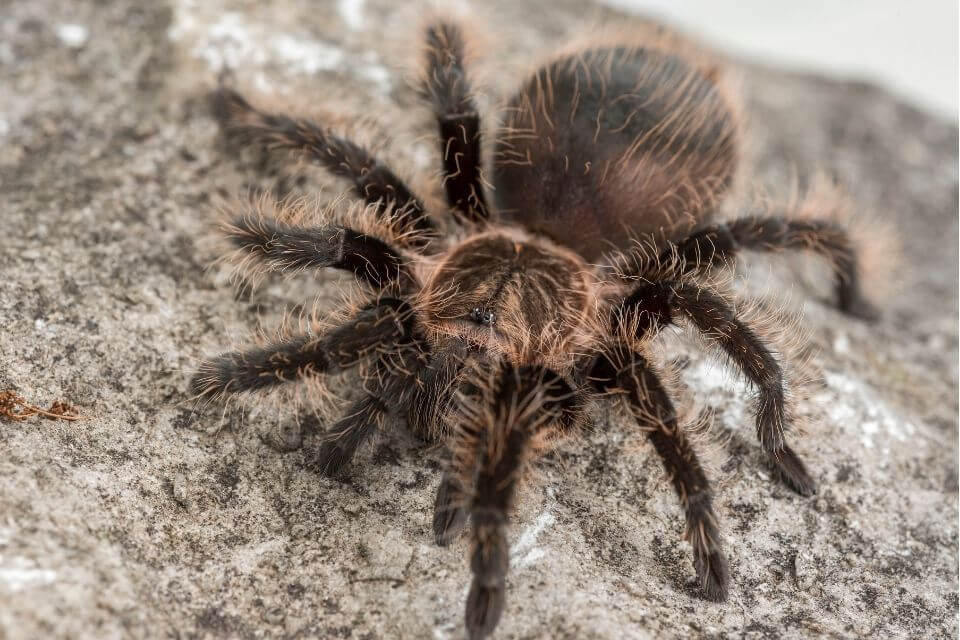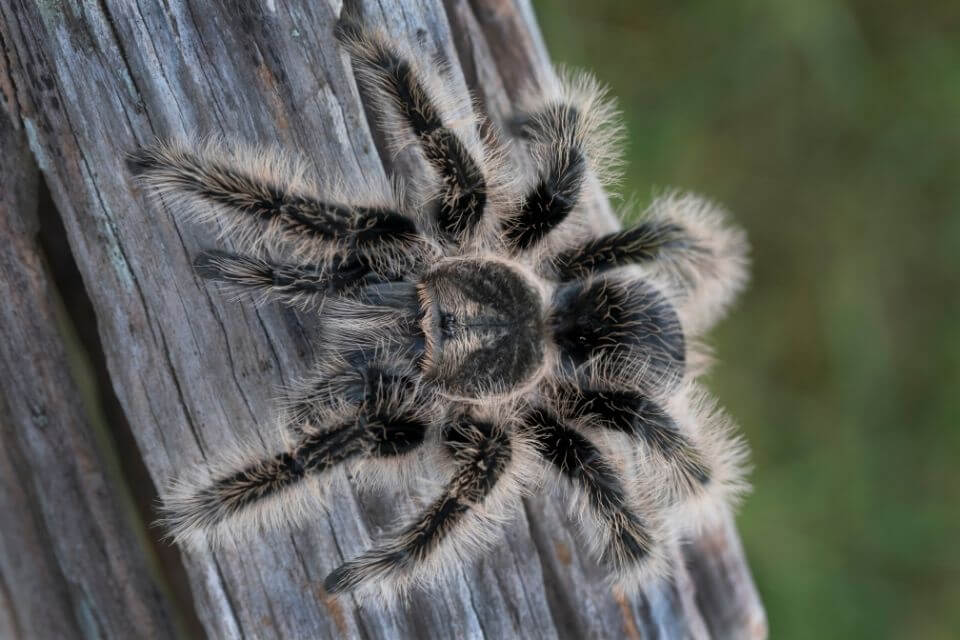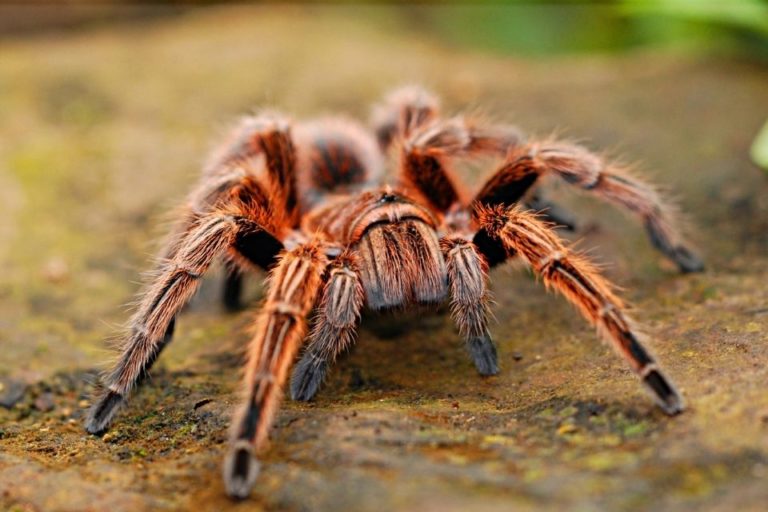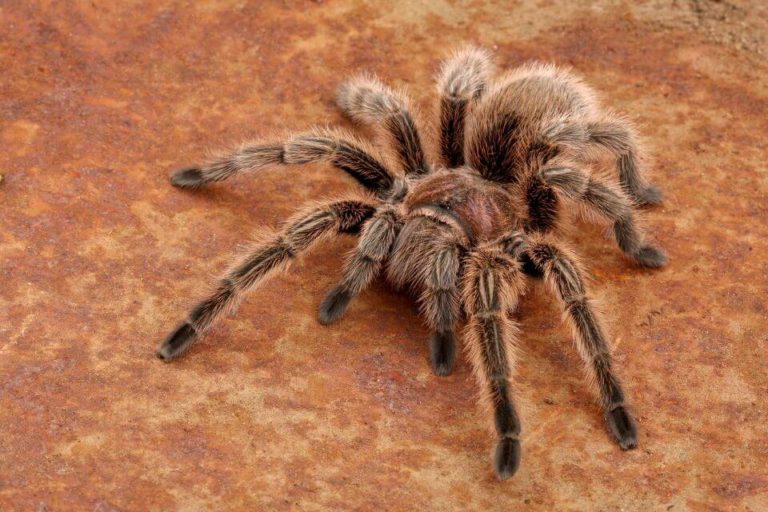Curly Hair Tarantula Care: Food, Tank Size, Lifespan, Behavior

Curly Hair Tarantula (aka Wooly Tarantula) is one of the easiest pet spiders that you can keep as it is non-aggressive and generally peaceful. These interesting creatures make fascinating pets and are relatively easy to care for.
In this blog article, we will discuss about all the facts of the Curly Hair Tarantula, exploring its unique characteristics, mesmerizing features, and the joys and challenges of keeping one as a pet.
Whether you’re an arachnid enthusiast or simply curious about the marvels nature has to offer, join us as we unravel the secrets behind this captivating creature.
Curly Hair Tarantula Overview
Tarantulas are large, hairy spiders that can be found in tropical and subtropical regions around the world. They are native to a variety of habitats, including forests, deserts, and scrub lands.
Even if these spiders blogs to tropical wild regions you can keep them as a pet in a suitable enclosure that mimics their natural habitat.
Curly Hair Tarantulas (Brachypelma albopilosum) are a type of tarantula that is found in the southwestern United States and Mexico. They get their name from their distinctive curly hairs, which help them stay cool in hot climates.
Curly Hair Tarantulas make excellent pets for people who love to keep exotic pets. They are popular pets due to their interesting appearance and relatively easy care requirements.
Curly hair tarantulas get their name from the distinctive curly hairs that cover their bodies. These Tarantula species can range in color from brown to black, and some species may have stripes or patterns on their abdomens.
They are generally docile creatures that make great pets for both beginners and experienced reptile keepers alike. They tend to be shy when younger but become more comfortable with handling as they mature.
It is quite hardy, so if you are worried about taking care of a pet, a Curly Hair Tarantula may be the perfect choice for you.
They spend most of their time hiding in their burrows, so you will not need to spend a lot of time or money on providing them with toys or activities.
Curly Hair Tarantula Behavior And Temperament
The Curly Hair Tarantula is a docile species that are generally not aggressive. They may hiss or puff up their hair when they are disturbed, but this is usually just a way to scare away potential predators.
Curly hair tarantulas can be handled without any problems as long as you are gentle and do not squeeze them too tightly. You might find these pets boring because they spend most of their time in their burrows.
When it comes to handling, it is best to wait until your tarantula is at least two years old. This will give them time to mature and become more comfortable with being handled. If you try to handle them too early, they may be scared and could even bite you.
The best way to hold a Curly Hair Tarantula is to cup your hands around them and support its abdomen. You should avoid holding them by their legs as this could damage them.
Tarantulas are not known for being cuddly pets, but some people enjoy handling them and letting them crawl on their arms or shoulders. If it feels threatened, Curly Hair Tarantula may try to bite.
They can kick hairs off their abdomens as a form of self-defense, which can irritate your skin and cause serious problems if they touch your eyes.
Curly Hair Tarantula Lifespan
Curly Hair Tarantula can live for up to 20 years in the wild, while in captivity their lifespan is about 8 to 10 years for females and 4 years for males if they are well cared for.
They should be kept in a warm, dry environment with a humidity level of around 50%. You can create the perfect habitat for your pet by using a terrarium that has been specifically designed for tarantulas.
Curly Hair Tarantula Size
Curly hair tarantulas can reach a size of up to six inches in length, including their legs. They are not the largest tarantulas out there, but they can be intimidating for people who are not used to handling them.
Curly Hair Tarantula Growth Rate
Curly hair tarantulas grow slowly and can take up to five years to reach their full size. Females grow larger than males, and they can live for much longer too. Additionally, their growth rate will depend on the care they receive and their diet.
Appearance And Colors

As the name suggests, curly hair tarantulas have distinctive curly hairs that cover their bodies. These hairs can range in color from brown to black, and some species may have stripes or patterns on their abdomens.
The colors of these tarantulas can vary depending on their diet and environment. This spider has the following characteristics:
- It has a round plump body that is covered in hair.
- The small bristles start on the lighter side when this spider is young, but they darken as it matures.
- The male’s fang size is smaller than the female’s.
- The tarantula has eight legs, each with two claws at the end.
- The first two legs are shorter than the others and are used for feeling around and catching prey.
- The other six legs are long and are used for walking.
- The hair on its body is usually brown or black, but some species may have stripes or patterns.
- Its abdomen is large and round, and it has a small head with two large eyes.
Curly Hair Tarantula Care
The Curly Hair Tarantula is easy to care for pets because they are not very active. They do not need a lot of space, and they can be kept in a small enclosure. However, it is important to make sure that their enclosure has enough ventilation.
Curly hair tarantulas should be kept in an environment with a temperature of about 75 degrees Fahrenheit and a humidity level of around 50%.
– Curly Hair Tarantula Tank Size
A ten-gallon tank is sufficient for one adult Curly Hair Tarantula. If you are keeping more than one spider, you will need a larger enclosure. It is important to provide enough hiding places and shelter for your spiders.
You can do this by using rocks, logs, or artificial caves. The spiders enjoy burrowing, so you may want to have a fair bit of depth in the substrate preferably three inches. They don’t like climbing much, so there is no need for a climbing accessory.
– Curly Hair Tarantula Habitat Setup
Below are some of the most crucial factors to consider when setting up your tank:
Substrate: The best substrate for Curly Hair Tarantulas is a mix of peat moss and vermiculite. You can also use coconut fiber or potting soil. Add pieces of cork bark or a small cave to give your spider somewhere to hide.
Light: Curly Hair Tarantula does not need a lot of light, so you can use a low-wattage bulb or LED lights. Additionally, the lighting should be kept on for about 12 hours a day.
Water & Humidity: You can provide a water dish for your spider, but they can also drink from the water droplets that form on the sides of the tank. You can increase the humidity by using a reptile humidifier or placing wet sponges in the tank.
Decorations: As mentioned earlier, curly hair tarantulas like to burrow. So, you should provide them with a substrate that is deep enough for them to do this.
You can also add rocks, logs, or artificial caves to their enclosure. Other decorations you can include are live or fake plants.
Plants To Put Inside the Tank: Some of the plants that you can put inside the tank include Pothos, Philodendron, Ficus, and Dracaena. These plants will help to increase the humidity levels in the tank.
Cleaning The Tank: You should clean the tank every two to three months. To do this, remove all of the decorations and substrate from the tank. Then, wash the tank with mild soap and hot water.
Rinse the tank well and let it dry completely before adding new substrate and decorations.
– Curly Hair Tarantula Diet And Feeding
Curly Hair Tarantulas are carnivores, so their diet consists of live insects. Some of the insects you can feed them include crickets, roaches, and mealworms. It is important to dust the insects with a calcium supplement before feeding them to your spider.
You should also provide a water dish for your spider to drink from. Juveniles should be fed every after two days while adult curly hair tarantulas can be fed once a week. During the summer, you can feed them every five to seven days.
You should always have food available for your spiders, as they may go without eating for several weeks at a time. The tarantulas prefer to sit back in wait and attack their prey from the burrows. Therefore, there is not enough substrate to dig into they might not eat.
Interestingly, you can not overfeed these species as they will stop eating when they have had enough. Remove any uneaten food within 24 hours to prevent the growth of bacteria and mold.
If you are having trouble finding live insects to feed your spider, you can also purchase them online.
Molting
All spiders go through a process called molting, where they shed their old exoskeleton and grow a new one. This process can take anywhere from two weeks to two months.
During this time, it is important to not handle your spiders as they are very fragile.
You will know that your spider is about to molt when they stop eating and their exoskeleton becomes dull. Once they start molting, you will see them shed their old exoskeleton in pieces.
After they have molted, it is important to provide them with a shallow dish of water so they can rehydrate. It is also important to note that spiders can sometimes eat their old exoskeleton as it is a good source of calcium.
Molting slows down as the spider gets older and can eventually stop altogether. Sometimes molting can get down to once per year for mature females while mature males may fail to molt at all.
When you notice your pet is on its back with its legs up, it is the beginning of molting.
However, if it is sitting with its legs hidden or rather tucked under itself, or has a poor-looking abdomen, you may want to seek the help of an experienced keeper or exotic veterinarian.
Common Health Problems
Curly hair tarantulas are generally very hardy and don’t usually experience many health problems. However, there are a few things to watch out for. One of the most common health problems with curly hair tarantulas is dehydration.
This can be caused by several factors, including low humidity levels in the tank, lack of water, or not enough food. If your spider is dehydrated, you will see them start to lose their hair and their exoskeleton will become dull.
Another common health problem is the infestation of mites. Mites are tiny parasitic insects that can live on your spider’s body. They can cause your spider to lose weight and may lead to death if not treated.
If you notice your spider has any of these symptoms, take it to an experienced exotic veterinarian for treatment.
Breeding Curly Hair Tarantulas
If you are interested in breeding curly hair tarantulas, it is important to know that they can be aggressive towards each other. It is best to house them separately unless you are an experienced breeder.
Before the mating season, it is important to fatten the female well to prevent any kind of aggression or possibly eating the male. Males and females reach sexual maturity at around three to five years old.
To breed them, you will need to place a male and female in the same tank. The male will start to build a web around the female’s body and will eventually mate with her.
After mating, the female will lay her eggs in a sac that she builds using her spider silk She can lay over 400 eggs. The eggs will incubate for about two months before hatching.
Once they have hatched, the baby spiders will be on their own and you will need to provide them with their own food and water.
Pros & Cons When Keeping It As A Pet
There are a few things you should consider before getting a curly hair tarantula as a pet.
Pros:
- They are generally very hardy
- Don’t require a lot of care
- They are interesting to watch
- Have a long lifespan of up to 20 years
- Relatively low price
Cons:
- The presence of irritating hairs
- Molting can be a stressful time for them
- Their legs can easily break off if handled too roughly
- Slow growth
- Inactivity
Other Tarantula Species As Alternative
If you are looking for an alternative to the Curly Hair Tarantula, there are a few other species that you may want to consider.
Chilean Rose Hair Tarantula: It is a good option if you are looking for a less hairy pet. They grow to be about six inches long and have a lifespan of around 15 years.
Mexican Red Knee Tarantula: They are a little larger than the Chilean Rose Hair Tarantula, growing to be about eight inches long. They also have a lifespan of around 15 years.
Goliath Birdeater Tarantula: It is the largest species of spider in the world and can grow to be up to 11 inches long. They have a lifespan of around 20 years.
Whichever species you choose, it is important to do your research to make sure you are prepared to care for your new pet. Tarantulas can make great pets if you are willing to put in the time and effort required to care for them properly.
Cost When Purchasing A Curly Hair Tarantula
When purchasing a curly hair tarantula, you can expect to pay anywhere from $20 to $50. The price will vary depending on the size and age of the spider. Moreover, this price range is for captive-bred spiders and does not include the cost of shipping.
Recurring Expenses When Keeping This Tarantula Species
There are a few recurring expenses you should be prepared to pay when keeping Curly Hair Tarantulas as pets.
The first is the cost of food. Curly hair tarantulas require a diet that consists mostly of crickets, but they will also eat other insects such as cockroaches, mealworms, and waxworms.
The cost of feeding a curly hair tarantula can add up over time, so it is important to factor this into your budget.
Another recurring expense is the cost of water. Curly hair tarantulas need to be kept moist at all times, so you will need to provide them with a water dish that they can access whenever they want.
Finally, you will also need to pay for the occasional vet visit. Tarantulas are generally hardy creatures, but they can still get sick from time to time. If this happens, you will need to take them to the vet for treatment.
Final Opinion To Consider Curly Hair Tarantula As A Pet
Overall, I think curly hair tarantulas make great pets for people who are willing to put in the time and effort required to care for them properly. They are interesting creatures to watch and have a long lifespan of up to 20 years.
Additionally, they don’t require a lot of care and are relatively affordable compared to other pet options.
Frequently Asked Questions
Here, you’ll find answers to common inquiries regarding the care and maintenance of these fascinating arachnids. Please read on to find answers to some of the frequently asked questions about keeping Curly Hair Tarantulas as pets.
Is Curly Hair Tarantula Aggressive?
Curly hair tarantulas are generally considered to be docile creatures and are not typically aggressive. However, they will defend themselves if they feel threatened.
Can You Handle Curly Hair Tarantula By Hand?
Curly hair tarantulas have delicate legs that can easily break off if handled too roughly. However, some spiders will not mind sitting on your hands for a while as long as you are gentle.
It is best to sit on the floor when handling a curly hair tarantula to avoid accidentally dropping it. Also in case, they feel scared, they can easily escape.
Do Curly Hair Tarantula Bite?
Curly hair tarantulas can bite if they feel threatened, but their bites are not typically harmful to humans.
If you are bitten by a curly hair tarantula, you may experience some swelling and redness at the site of the bite. However, this should go away within a few days.
Are Curly Haired Tarantulas A Friendly Pet For Kids?
Curly hair tarantulas are not typically recommended for children as they can be difficult to care for properly. However, if you are willing to put in the time and effort required to care for them, they can make great pets for kids.
It is important to remember that all kids should be supervised when interacting with any type of pet.
How Venomous Are Curly Haired Tarantulas?
Curly hair tarantulas are not venomous and their bites are not typically harmful to humans. However, if you are allergic to spider bites, you may experience some swelling and redness at the site of the bite.
If this happens, you should seek medical attention immediately.
Can we keep two Curly Hair Tarantula in the same tank?
The simple answer is no because the majority of Tarantula species do not share the same territory. They see each other as a threat and start fighting each other by showing their Cannibalistic behaviors.
You can only keep one Tarantula in a single enclosure. But for keeping male and female Tarantulas together in the same enclosure for breeding purposes may not be a problem.



